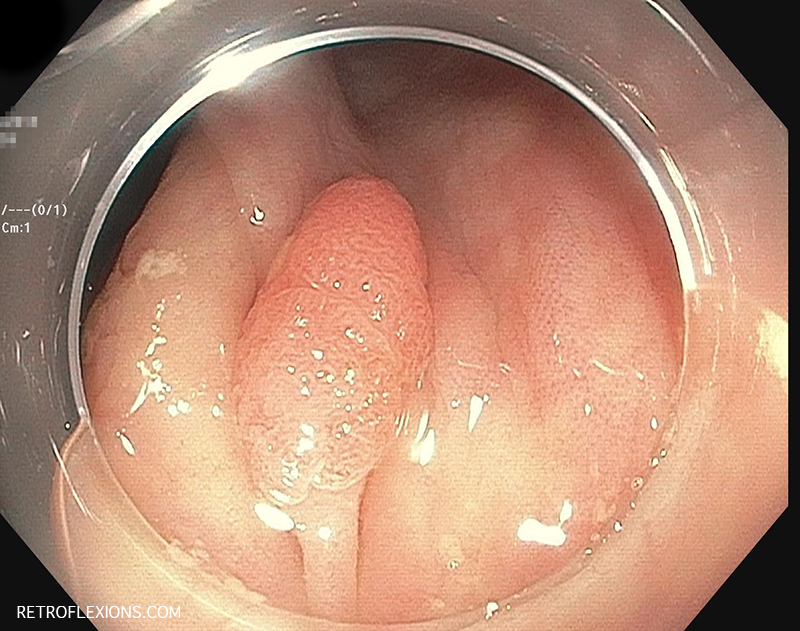After Colon Polyps Are Removed How Ofern Should a Person Be Checked Again
And then far we have covered the basics of screening colonoscopy, which is done to look for polyps or colon cancer in people without signs or symptoms of these bug. Merely what about when a polyp is found? How exercise we follow these patients going forwards?
In one case a polyp is discovered and removed, patients are put into a surveillance colonoscopy protocol. Surveillance means keeping a close eye on something, so when we find that a item patient has a habit of forming polyps, we snoop around looking for problem a piddling earlier (instead of waiting the full 10 years for the next colonoscopy).
Three factors determine the surveillance interval:
- The size of the largest polyp constitute on the prior colonoscopy.
- The number of polyps found on the prior colonoscopy.
- The most advanced histology institute on the concluding colonoscopy.
Information technology'south worth noting that all of these recommendations are for patients without a family history of colon cancer. These guidelines also assume that the bowel was fairly prepped, and that all polyps establish were completely resected. There are seperate guidelines that pertain to surveillance of serrated lesions, large lesions that were non completely resected in one session, and for repeating exams in patients with suboptimal bowel prep, merely these are beyond the scope of this article.

Adenomatous polyp
Here are the recommendations for the well-nigh mutual situations encountered afterward a screening colonoscopy:
You need the next colonoscopy in 5 years if:
- one or two pocket-sized (<10 mm) tubular adenomas were found.
You need the side by side colonoscopy in 3 years if:
- three or more than pocket-sized (<ten mm) tubular adenomas were found; or,
- at to the lowest degree one large (>10 mm) tubular adenoma was found; or,
- any polyp had villous features (villous adenoma or tubulovillous adenoma); or,
- any polyp had loftier-class dysplasia (sometimes called "carcinoma in situ").
You need the side by side colonoscopy in "less than" 3 years if:
- more than 10 adenomas were found.
- invasive colon cancer was found in a polyp.
If y'all detect, the basic idea here is pretty simple. According to the guidelines, there are actually but a few options for follow-upwards intervals for colonoscopy: 10 years (negative test), 5 years (depression-risk polyps), and iii years (high-risk polyps). Less than 3 years is simply recommended in the truly unusual instance of a large polyp burden or invasive cancer in a polyp. And that's it.
Despite the existence of evidence-based guidelines, I ordinarily hear the following statements from patients (note: this is not a reflection on the patient, but on their doctor):
"I go a colonoscopy every twelvemonth because I always have polyps."
This is very unusual…In the absence of a genetic syndrome, nearly patients shouldn't form new polyps one year after a colonoscopy. Are all the polyps being removed on each colonoscopy, or just the larger ones? What is the histology of the polyps?
"I had i small polyp last fourth dimension, and so my dr. does a colonoscopy every ii years because my aunt had colon cancer."
An aunt with colon cancer is not a first-degree relative, and there is no recommendation to alter the screening interval for this reason. Furthermore, in that location is no recommendation for whatever ii-yr surveillance interval in the guidelines. You have to inquire your doctor where this recommendation came from, and then promise for some reasonable respond.
"I've been getting colonoscopies every twelvemonth since I had a polyp plant about viii years agone. My physician told me it'due south very important to become every year!"
Unfortunately, I hear this one somewhat commonly. Unless y'all have a proven genetic cancer syndrome or inflammatory bowel disease, there is no recommendation for yearly colonoscopy. My advice is to inquire your doctor why he or she is recommending such an aggressive surveillance schedule. Unless they remind yous that you take a genetic cancer syndrome or inflammatory bowel disease, it'due south time to find another doctor!
In conclusion, screening colonoscopy is very important to identify and treat asymptomatic patients to prevent the future development of colorectal cancer. However, surveillance is just as of import since it focuses further prevention efforts on a subgroup of patients (i.due east., the "polyp formers") who accept a college gamble of developing colorectal cancer down the line. It would be neither feasible, nor desirable for the average person to have a colonoscopy every three years, merely for a highly-selected group of patients who have a history of avant-garde polyps, that colonoscopy in 3 years may be the one that picks up the side by side lesion that was on schedule to turn into a cancer in five years. That is the purpose of a surveillance protocol, to continue a closer heart on the ones who need it.

"I'm on to you, bub. Look at this 12-mm adenoma yous were hiding in your ascending colon! I'll exist seeing you again in three years."
Reference:
Lieberman DA, Male monarch DK, Winnower SJ, et al. Guidelines for colonoscopy surveillance subsequently screening and polypectomy: a consensus update by the Usa Multi-Social club Task Force on Colorectal Cancer. Gastroenterology 2012;143:844-57.
Images via Setreset and Gadi Dagon
If y'all enjoyed this article, sign up for our free newsletter and never miss a post!
Source: https://retroflexions.com/endoscopy/my-doctor-found-a-colon-polyp-when-do-i-need-to-repeat-a-colonoscopy/
Post a Comment for "After Colon Polyps Are Removed How Ofern Should a Person Be Checked Again"